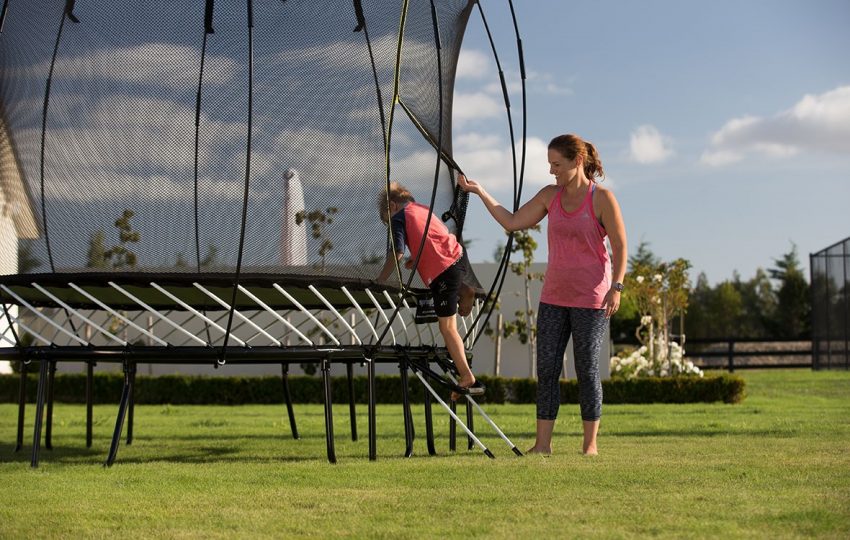Trampolines aren’t what they used to be. Thankfully, they’ve come a long way from the rusty old springs of our childhood. But with so many variations out there in the market – in both old and new designs – it can be hard to tell them apart, and tricky to find the best option for you.
For many families, they’re looking for the safe option. And ideally, a trampoline that will stay as safe as the day they bought it, for years.
But what does a ‘safe’ trampoline actually mean?
Dad and mechanical engineer Dr. Keith Alexander asked himself the same question. And he dedicated 15 years of his life to building the answer.
Meet Keith. He’s a proud father. An inventor and pioneer. A professor of mechanical engineering. And the creator of the world’s safest trampoline. He dedicated a large chunk of his life to first discover what needed to change to make trampolines safer, and then to make those changes. In fact, he completely re-designed the trampoline from the ground up. What compelled him so strongly that he did this? His kids.
When Keith wanted to get a trampoline for his daughter, his wife Faith told him “no way, they’re way too dangerous.” He did the research and found she was right. Being an engineer, Keith thought he might be able to solve that problem. And so he set out to do just that.
In the words of Keith himself, “trampolines were resulting in too many injuries.”
“I realized there needed to be a design that did away with the features that were causing injury,” he says.
“There needed to be a product where the safety features lasted the life of the trampoline itself. There also needed to be effective ways of teaching people how to use trampolines safely. And finally, there needed to be research and development that identified what caused injuries, and that solved both the engineering and education problems.”
What needed to change?
Keith says the most concerning aspects of traditional trampolines were “the pads that were supposed to cover the springs and frame, the enclosures that were supposed to stop children falling off, and the safety standards at the time, which used to allow the enclosures to be optional.”
“These components had to last and remain effective for the life of the trampoline, and could not be seen as optional, or as disposable maintenance items,” he says.
Eventually, a court case in America meant that all trampolines sold in the US had to have an option for a net enclosure. But years on, after Keith did further research into the causes of trampoline injuries, it became clearer what the biggest issues were.
“In short, the big problem was that from 2002 to 2010, there was little or no measurable change to trampoline injury statistics, for the injuries that were meant to be reduced by safety pads and enclosures,” says Keith.
“Which meant safety pads and enclosures were not making an impact on reducing trampoline injuries. And this of course was a huge concern.”
The result of Keith’s work?
Keith’s hard work paid off. He changed trampolines forever by introducing a safe design to the market, raising the benchmarks for trampoline safety.
The unique, patented Springfree Trampoline is acclaimed as the world’s safest trampoline. It eliminates all the hard impact points that caused 90% of all product-related trampoline injuries. With no springs, no hard edges and no hard metal poles to jump into, it presents a much safer choice.
What makes Keith’s design so much safer?
“The dangerous features of traditional trampolines have been designed out of the equation,” says Keith.
“It is built like a rubber room. There are no springs to fall between, no steel bars or hard metal poles to fall on. Basically, all of the hard impact points have been removed.”
“The Springfree Trampoline design needs no pads because the edge itself is resilient. So you don’t hurt yourself when you fall on it.”
“It has a net that stops you falling off. That net is flexible and supported by flexible poles so if you do completely lose control, you are caught softly and deflected back onto the trampoline mat.”
“The frame on the Springfree Trampoline is well below the mat, so the jumper cannot come into contact with it while jumping.”
“The whole unit is built to last, with those features essential to safety remaining in place for the life of the trampoline. The research has been done to show that it is much safer than traditional trampolines, and of course, I’m really happy with that result.”
– Dr. Keith Alexander, Father, Professor of Mechanical Engineering & Inventor of the Springfree Trampoline.
Enjoy reading this article? You can learn more about Keith’s invention and his story on the Springfree Trampoline website, or learn more about Springfree’s safety features.
You may also like to read:
Trampoline buying guide: What do the Safety Standards mean?
Top 5 Health Benefits of a Trampoline
Are you a Helicopter Parent? How to Keep Your Brave Kids Safe









